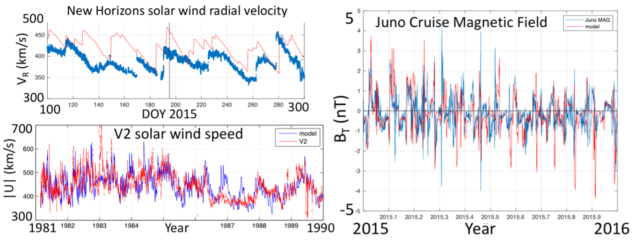Solar Wind Predictions at Jupiter and Mars
Measurements of the solar wind conditions upstream of planetary magnetosphere are typically not available concurrently with in situ magnetospheric measurements. Therefore, we must rely on models that propagate solar wind data measured at the Earth’s orbit at 1 AU out to planetary orbits, including Jupiter’s orbit at 5.2 AU. This website hosts model output files from a 2-D multi-fluid MHD solar wind propagation model, called SWMF-OH, that predict the solar wind conditions upstream of Jupiter during Juno’s prime and extended missions (2014-present). We provide solar wind predictions at both Mars and Jupiter, for comparison with MAVEN and Juno in situ data, respectively, and at Juno’s position in the solar wind during its approach to Jupiter (2014-2016).
The SWMF-OH model was adapted by BU Senior Research Scientist Bertalan Zieger from the outer heliosphere (OH) component of the Space Weather Modeling Framework (SWMF) (Tóth et al., 2012), which is a 3-D global multi-fluid MHD model of the outer heliosphere with one ion fluid and four neutral populations (Opher et al., 2006; 2009). It provides time-dependent 2-D multi-fluid MHD simulations of solar wind propagation from a heliocentric distance of 1 AU up to 50 AU. Model inputs are hourly OMNI data of the measured solar wind density, velocity, magnetic field, and temperature. Model outputs include the solar wind density, plasma temperature, velocity, and all three components of the IMF.
Model output files: (last updated 3 March 2023 – now includes model output through the end of 2022)
- Jupiter: 2014, 2015, 2016, 2017, 2018, 2019, 2020, 2021, 2022
- Juno (cruise): 2014, 2015, 2016
- Mars: 2014, 2015, 2016, 2017, 2018, 2019, 2020, 2021, 2022
The files include: year, month (integer number 1-12), day (integer number 1-31), hour, position in HCI cartesian coordinates, solar wind number density, solar wind velocity in RTN coordinates, interplanetary magnetic field in RTN coordinates, solar wind thermal pressure, and current density in RTN coordinates (see header line in each file for units).
A significant advantage of this model is that it can predict all three components of the interplanetary magnetic field. 1-D MHD models cannot propagate BR because of the divergence-free nature of the magnetic field (see discussion in Zieger and Hansen, 2008). Predicting the IMF is crucial for fully understanding the interaction between the solar wind and Jupiter’s magnetosphere, for example in determining whether the IMF orientation was favorable for dayside reconnection. Additionally, SWMF-OH does a good job of predicting intervals of increased solar wind PDyn from corotating interaction regions even when the Earth-Sun-Jupiter angle is large. Finally, it is useful to consider output from multiple models wherever possible, since we can have additional confidence in the predictions when results of different models agree.
SWMF-OH has been used predict the conditions at Pluto and along the New Horizons trajectory and was one of the most successful models in the New Horizons Flyby Modeling Challenge at the Community Coordinated Modeling Center (CCMC). The top left panel in the figure above demonstrates the reasonable fit between the predicted (red) and observed (blue) solar wind speed near Pluto. The model has been successfully validated with Pioneer 10 and Voyager 2 data (figure bottom left). Preliminary results of solar wind propagation to Juno during its cruise phase to Jupiter (Moore et al., 2017), shown in the right panel above, demonstrate that not only the plasma parameters but also the interplanetary magnetic field (IMF) can be reasonably well predicted with the SWMF-OH at Jupiter’s orbit. The expected timing errors have not yet been quantified, but we anticipate that they are roughly similar to mSWiM (10-15 hours for high recurrence index, ~35 hours for a low recurrence index).
Other solar wind propagation models include:
- mSWiM (Michigan Solar Wind Model), see Zieger and Hansen (2008) – a 1-D MHD model that propagates OMNIWeb solar wind data from the Earth’s orbit at 1 AU to as far out as 10 AU. Model outputs include the solar wind density, plasma temperature, and the interplanetary magnetic field (IMF) and solar wind velocity components in RTN coordinates.
- MSWIM2D, see paper by Keebler et al. 2022 – similar to mSWiM but propagated in 2-D using the BATSRUS MHD solver
- Tao et al. (2005) model – a 1-D MHD model that propagates OMNIWeb solar wind data (model inputs are the measured solar wind mass density, velocity, magnetic field, and thermal pressure) from 1 AU out to the orbits of Jupiter and Saturn. Model outputs are the solar wind density, the radial component of the solar wind velocity, the solar wind speed, and one component of the IMF and are available from AMDA.
This work is funded by NASA’s New Frontiers Data Analysis Program and the Juno Participating Scientist program. Please contact Marissa Vogt and Bertalan Zieger with questions or comments.
